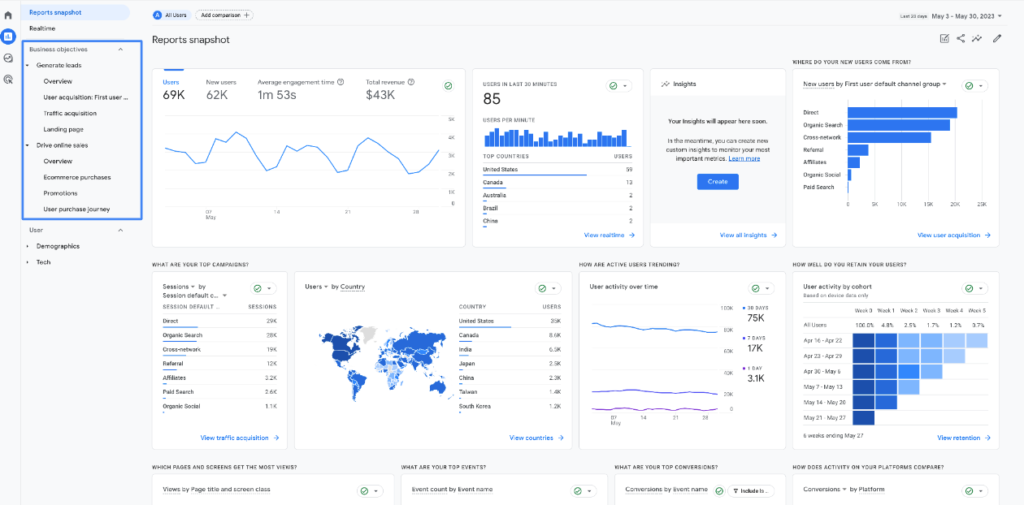
GA4 and Your Digital Marketing Strategy: What You Need to Know
In the realm of digital marketing, data is king. The ability to gather, analyze, and act upon data is crucial for crafting effective strategies and achieving meaningful results. Google Analytics 4 (GA4), the latest iteration of Google’s analytics platform, is here to provide digital marketers with enhanced capabilities and insights. In this blog post, we’ll delve into how GA4 can elevate your digital marketing efforts and provide valuable data-driven insights. The Evolution of Google Analytics Google Analytics has long been a cornerstone of digital marketing, offering invaluable insights into website and app performance. With the advent of GA4, Google has reimagined its analytics platform to address the changing needs of digital marketers in an evolving digital landscape. Here’s why GA4 is a game-changer: 1. User-Centric Data GA4 shifts the focus from session-based data to user-centric data. It provides a more comprehensive view of user interactions across multiple devices and platforms. This means you can gain a deeper understanding of user behavior and preferences, enabling more personalized marketing strategies. 2. Enhanced Event Tracking Event tracking in GA4 is more robust and flexible. You can now track a broader range of user interactions, including scrolls, video views, file downloads, and more. This level of granularity allows you to measure user engagement accurately and tailor your content accordingly. 3. Predictive Metrics GA4 introduces predictive metrics that can help you anticipate future trends and user behavior. For instance, it can predict potential revenue and churn rates, allowing you to take proactive measures in your digital marketing strategy. 4. Cross-Platform Tracking In an increasingly multi-device and multi-platform world, GA4 excels at cross-platform tracking. It seamlessly integrates data from websites, apps, and even offline sources, providing a holistic view of user journeys. 5. Enhanced User Privacy With a growing emphasis on user privacy, GA4 is designed to align with evolving privacy regulations. It supports more granular consent options and allows you to manage data collection in compliance with user preferences. GA4 and Your Digital Marketing Strategy: Key Insights Now that we’ve covered the significant improvements GA4 brings to the table, let’s explore how it can enhance your digital marketing strategy: 1. In-Depth User Behavior Analysis GA4’s user-centric approach allows you to track individual user journeys comprehensively. This means you can analyze how users interact with your website or app over time, helping you identify key touchpoints and opportunities for engagement. 2. Advanced Segmentation GA4 offers advanced segmentation options that enable you to create highly targeted audiences based on user behavior, demographics, and other criteria. This is invaluable for crafting personalized marketing campaigns that resonate with specific user segments. 3. Improved Conversion Tracking With GA4’s enhanced event tracking, you can track a wide range of conversions, from form submissions to video views to e-commerce transactions. This level of detail helps you understand which actions drive conversions and optimize your marketing accordingly. 4. Predictive Analytics Leverage GA4’s predictive metrics to anticipate user behavior and trends. For example, you can identify users at risk of churning and implement retention strategies or forecast revenue based on historical data. 5. Enhanced Attribution Modeling GA4 offers more flexible attribution modeling, allowing you to assign value to touchpoints in the user journey. This helps you understand the contribution of various marketing channels and optimize your budget allocation. 6. Privacy Compliance GA4’s built-in privacy features help you stay compliant with data protection regulations. By respecting user consent preferences and ensuring data security, you build trust with your audience. Google Analytics 4 (GA4) is a powerful tool that can significantly enhance your digital marketing efforts. Its user-centric approach, enhanced event tracking, predictive metrics, cross-platform capabilities, and privacy features make it a valuable asset in the modern digital landscape. By leveraging GA4’s capabilities, digital marketers can gain deeper insights into user behavior, optimize their strategies for higher conversions, and stay compliant with privacy regulations. As you embrace GA4 in your digital marketing toolkit, you’re better equipped to craft data-driven strategies that drive meaningful results and stay ahead in the competitive digital marketing arena.


